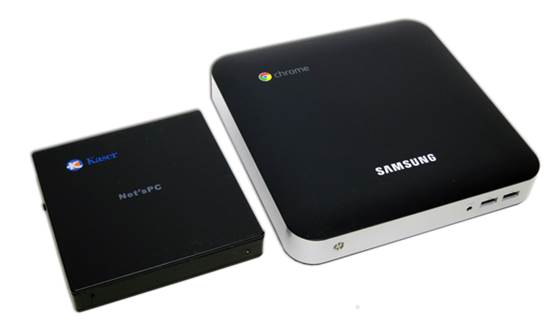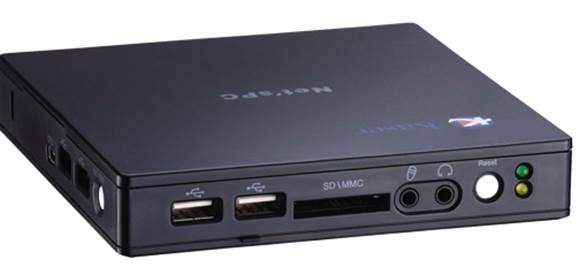Kaser Net’sPC2 YF810-8G
Net’sPC2 FYF810-8G is presented in an
incredibly small form factor. The black square is much smaller than Apple Mac
Mini, Intel NUC, or Chromebox of Samsung.
Net’sPC2 is also unbelievably lightweight,
which is slightly worrisome, as it lighter than anything else on my working
desk, except for its mouse. I understand the small form factor, but it’s not
small enough to explain for the lack of weight of the platform. Combining with
the plastic cover which feels cheap of the device, we have the feeling of low
built-quality in overall.

Net’sPC2
FYF810-8G is presented in an incredibly small form factor.
Aside from the platform itself, Net’sPC2
YF810-8G of Kaser comes with power adapter, VESA mounting frame, landline
keyboard, and optical mouse. Adapter is a common type, and the mounting frame
is a piece of metal with companion thumbscrew. Actually, there’s not much.
Keyboard and mouse are laptop-sized
version. And they can be cheap. Under the keyboard is only a fastened bare
metal slab, which throughout the test made the entire thing curve upward on
both sides and bend inward at the center. If that’s not enough, it also
clanks. It’s obvious that something is broken on the inside. The moving gaps
of the keys can also be compared with the most basic laptops, though with the
spongier feeling than the cheapest netbooks.

Keyboard
and mouse are laptop-sized version.
The mouse which is as light as a feature
withstands much better (though we believe that a drop on the solid ground will
lead to its death). The transparent cover emits red light from the optical
sensor, which depends on your personal taste, can be considered as amazing or
annoying. At least it has the scrolling wheel.
Just need to say that the uncompleted metal
mounting frame is the most solid thing that comes with YF810-8G.
The top of the unit is very simple, which
only consists of the “Net’s PC” name (lacks number 2) written in medium-gray, sitting
at the middle of the unit, and full-colored Kaser logo sits on the top left
corner.
The underside of Net’sPC2 has a big air
vent at the middle, the rubber pieces at each corner and a while sticker contains
serial and model info. The sticking material used to attach the rubber pieces
to the unit can’t withstand the temperature of the combined temperature of the Nettop
and the screen which it’s mounted to. During the testing process, one of the
four pieces goes loose and is sucked by the vacuum cleaner.
The top of Kaser has (from left to right) 1
Kensington Security Slot, a single On-The-Go USB port, 2 USB 2.0 ports and on/off
button.
The left of the Net’sPC2 has (from left to
right) 2 additional USB 2.0 ports, SD/MMC card reader, headphone and mic jack,
reset button, green LED power indicator, and an orange LED operating indicator.
The right of YF810-8G is the place of (from
left to right) the power switch, power plug, Ethernet jack, along with
connector for VGA and HDMI output.

With
the ports filling all except for one side of Net’sPC2, the accompanied VESA
mounting frame is obviously intended for using
The bottom of Kaser only contains an
instruction knob and the lock hole for VESA.
With the ports filling all except for one
side of Net’sPC2, the accompanied VESA mounting frame is obviously intended for
using. Or else, the small form factor system will become an octopus with cables
that can quickly become a mess even on a large working desk.
While the form factor of Kaser pushes the
limit about providing a small size, that’s largely because the internal
hardware is not quite impressive, even according to the CE standard. At the
heart of Net’sPC2 is Allwinner Tech A10 SoC, equipped with the only Cortex-A8
core running at 1GHz. That’s the same processing power delivered by the
original iPad.
The graphics technical specs are not quite
impressive. Allwinner takes full use of Mali-400 MP GPU of ARM, the same
structured architecture appearing on devices such as Galaxy Note II of Samsung.
However, Exynos 4412 SoC in Note is equipped with a total of 4 Mali-400 MP GPU
cores; Kaser only has one.
In short, A10 is not a flagship SoC, which
is certainly the reason why Kaser only gives it 512MB DDR3-800 RAM and 8GB
flash 25nm asynchronous NAND.
But the question is: how does the
combination of Android and keyboard/mouse perform in use?